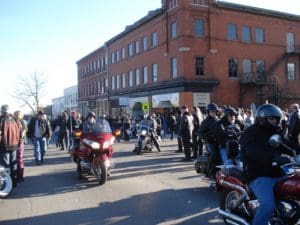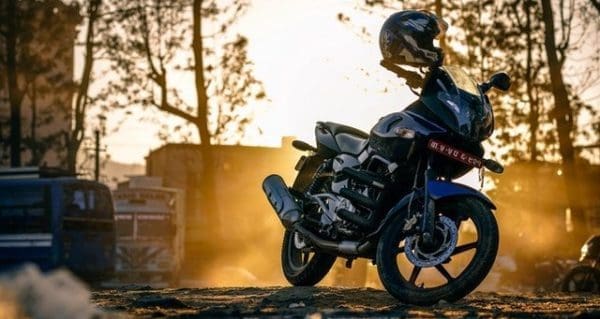 It may not seem like it, but motorcycle riding season is just around the corner … really.
It may not seem like it, but motorcycle riding season is just around the corner … really.
But after a six-month absence, you may find yourself a little rusty as you head into the sunshine. It’s easy to forget how vulnerable you are on a motorcycle and, more to the point, how mind-bogglingly thoughtless and stunned motorists can be.
Traffic is worse than ever, with more cars, trucks and buses on the road, and more opportunities for disaster. Some things to keep in mind before you frappe la route:
• Get everything buttoned up and have all your bits and pieces stowed away. Make sure your helmet is on properly and you have the right kind of eye protection. Don’t just throw on a pair of cheap sunglasses; make sure your goggles or whatever you use keep the wind out and don’t shift when you’re underway. You don’t want to be fussing around with glasses, gloves, zippers or any other flotsam once you’re up to speed.
• Ride as if you’re invisible. Countless studies have amply demonstrated that motorists don’t register a motorcycle in their brains in the same way they take note of a car or truck. Ride as if they don’t know you’re there and stay out of their way.

The Port Dover, Ont., Friday the 13th Motorcycle Rally is held, you guessed it, every Friday the 13th. The next one is set for Friday, July 13, 2018. There’s no better time to practise your safety protocol than when surrounded by other riders.
• Stay close to the centre line if there’s one lane of traffic, over a shade to the right if there’s two. But don’t ride in the middle of the lane – that’s where all the oil drips and it can be slick, especially if the road is wet. It’s less likely that the driver in oncoming traffic is going to veer into your lane, and more likely that the guy beside you will try to get into your lane without looking or even caring that you’re there.
• Don’t hug the curb, regardless of how many lanes there are. Adopt a safety cushion when you’re riding. In other words, make sure you’ve got room to manoeuvre at all times and treat that space on the road as if you own it. While you’re out there, this is your turf and intruders are not welcome.
• Make yourself as visible as you can to drivers, and never ride directly beside them or get caught in the blind spot. Try to be by yourself as much as possible.
• Take nothing for granted. If you’re riding and there’s a guy ahead of you waiting to turn out of an intersecting street, for example, don’t assume that he’ll wait for you to pass before he executes the turn. Think about an exit strategy, if there is one.
• Look beyond the vehicle in front of you. Try to predict what that guy in the pickup truck at the end of the block is going to do. Will he try to sneak in a left turn in front of you? Is he fully in his lane? Is he speeding? Is he looking for something?
• Make eye contact with drivers whenever possible. When you pull up beside that guy on your right, look him right in the eye. Let him know that this is a flesh-and-blood human here, not an apparition. Don’t get in his face, just try to make him aware of your presence. A friendly wave or nod wouldn’t hurt.
• Shoulder check, shoulder check, shoulder check. Of course it’s a good idea to remember what car is where when you’re underway and you should check your mirrors every couple of seconds. But do not – I repeat, do not – change lanes, turn left or cross an intersection without doing a shoulder check and/or looking right and left. Don’t just sit there like a lump; be as active as you can on the bike.
• Try to remember that you have ears as well as eyes, and listen for approaching cars and trucks. This is especially true when things get busy. If you’re merging onto a busy highway, for example, listen as well as look.
• Now that you’re comfortable, start to work the bike a bit. Accelerate away smartly from stop lights and get a sense of the bike’s power. Experiment with the brakes and see how this little puppy stops. Lean it over through the turns and, if you have the nerve, don’t be afraid to scrape the foot-pegs. The bike will not let you down.
• Remember what your instructors told you about keeping moving at slow speeds. If you’re executing a tight turn in a parking lot, for example, keep your forward momentum going. As long as you’re moving, it’s almost impossible for the bike to fall over. And remember what you’ve been told about trail-braking: the best way to decelerate before you take a turn at speed is via the rear brake. Hitting the front brake changes the bike’s balance and weight distribution and may lead to trouble.
• Keep your wits about you. Pay attention at all times. Don’t ride if you’re fatigued or have had a drink.
And enjoy yourself – it’s not Death Race 2000 out there.
Even if it sometimes seems like it.
![]() Ted Laturnus has been an automotive journalist since 1976. He has been named Canadian Automotive Journalist Of The Year twice and is past president of the Automotive Journalists Association of Canada (AJAC).
Ted Laturnus has been an automotive journalist since 1976. He has been named Canadian Automotive Journalist Of The Year twice and is past president of the Automotive Journalists Association of Canada (AJAC).

